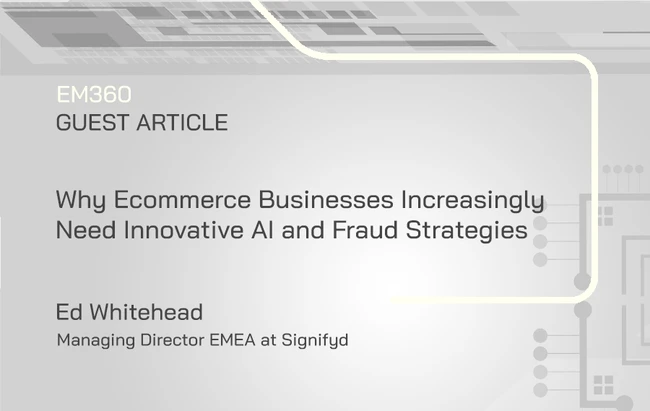
Online fraud is changing, but so is the way that risk teams are dealing with the threat of fraud and abuse. Smart machines and big data mean that businesses can be armed against fraud — they’re no longer playing defence.
Now, modern risk teams have seized the role of optimising business revenue, rather than focusing on loss avoidance. This reframed role means that progressive risk teams are no longer a cost recovery centre but have become their own revenue generator.
In Signifyd’s e-commerce data report, we explore how fraud strategies and artificial intelligence (AI) are key to fraud and abuse prevention solutions.
Article by Ed Whitehead, Managing Director EMEA at Signifyd
The rise of fraud teams
Fraud teams can no longer be the only defence against abuse. Since the dawn of ecommerce, the online side of the retail house has been somewhat shielded from the ill effects of an economic downturn or a strategic misstep by businesses.
For many retailers, online sales only made up a single-digit percentage of revenue. But with the surge in ecommerce during the pandemic, ecommerce revenue reached 33% of retail sales, according to Signifyd’s Pulse Report. Now online commerce is a key part of the business, and it needs to perform like it.
Therefore, fraud prevention has changed. It has become a risk intelligence for forward-thinking retailers. Risk teams are no longer cost centres being asked to squeeze spending while improving performance. At the most successful retailers, risk teams work on enabling the enterprise’s strategic objectives. They turn to artificial intelligence to maximise approval rates with decisions that are made in real time and allow buy online, pickup in store and curbside pick up to run efficiently and profitably.
Using big data
Dynamic insight is the best way to understand your customers and the risk that they can carry. Merchants can utilise commerce protection platforms to access adaptive artificial intelligence and machine learning back-end monitors to assess customers with vast datasets.
This assessment means that those who would abuse your store are blocked from purchasing in the moment. This block is conducted if their intentions aren’t explicit or identifiable at the checkout.
But it’s not just about blocking fraudulent consumers; using AI and data means that genuine customers have a better experience. Traditional risk analysis may knock consumers back, asking for additional verification. However, intelligent decision centres can calculate the risk of a customer the first time around, meaning that there are no awkward declines.
Merchants can also gain access to a single view of all transaction information thanks to the intuition of AI. Historical reports and fraud trends can also be used to understand where fraud teams need to target the most, aiding revenue optimisation.
What is your fraud maturity?
We now recognize that fraudsters will continue to change their tactics along with the ecommerce landscape.
Adaptability and agility are now more important than ever for risk and fraud teams. They are core competencies necessary to prevent the costly revenue leakage that can ensue from fraud attacks or throughout an order’s lifecycle — at the payment gateway, the card processor, through anti-fraud efforts, and even after delivery, through returns and chargebacks.
Retailers must take time to assess and identify areas for improvement for an effective long-term strategy. This is key when it comes to your fraud team, one of your first lines of defence against revenue leakage.










